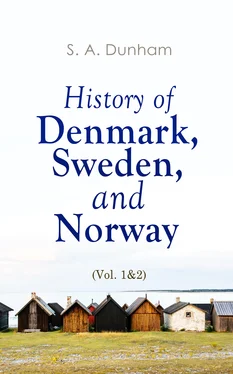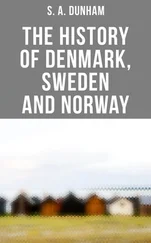The confusion at this period of Swedish history, viz., from the close of the eighth to that of the tenth century, is greater than at any former period. No fewer than sixteen kings are said, by different historians, to have swayed the Swedish sceptre in little more than two centuries. The cause of this confusion is very obvious. Not only were the kings of Gothland, when that province happened to have a separate king, enumerated with those of the Swedes, but the successors of Olaf Trætelia were equally confounded with them: in other words, the royal chiefs of three contemporary states have been classed as kings of the Swedes only—as the sovereigns of Upsal. This confusion has rendered it scarcely possible to distinguish either the royal names of each state, or the actions attributed to them. We may, however, assert, with confidence, that Olaf Trætelia, and Ingel (or Ingiald), his son, were not kings of the Swedes; on the contrary, they were sovereigns of a state far to the west—Vermeland and Raumarik. [157]If, as some historians assert, a king named Charles reigned at this time in Sweden, his seat could not have been Upsal; it must have been some town of East or West Gothland. The same may, we think, be asserted of Emund , who reigned in the south, while Biorn reigned at Upsal, or Birca. But Eric IV., surnamed the Victorious , was certainly king of both the Goths and the Swedes. The successful wars in which he engaged, and which procured him that epithet, are too obscure to be distinguished from the chaotic events of this period. Eric V. , surnamed Arsaell , or the Happy-born, the father of Olaf Skotkonung, was also king of the two provinces. He embraced Christianity, and was baptized in public at Upsal, together with many of his nobles. It was, probably, as much for this reason, as for the extraordinary abundance which Sweden enjoyed in his time, that he obtained the epithet that posterity has attached to his name. There is much obscurity over this monarch’s reign. By some writers he is said to have been so alarmed at the murmurs of his people, for his abandonment of the old religion, that, to pacify them, he reverted to it. By others, again, it is asserted that he stedfastly adhered to the new faith; that he laboured, with some success, to withdraw his subjects from the errors of idolatry; that he went so far as to demolish the heathen temples; that at Sigtuna he met with little opposition; but that, when he ventured to lay hands on the magnificent temple of Upsal, the people arose and put him to death. To reconcile these contradictions would be a vain attempt. All that yet remains to be communicated respecting this, and one or two preceding reigns, may be found in the chapter devoted to the origin of Christianity in these regions. [158]
Table of Contents
ABOUT A.C. 70 TO A.D. 1030.
NEW KINGDOM OF THE YNGLINGS IN VERMELAND.—KINGS FROM OLAF TRÆTELIA TO HALFDAN THE BLACK.—HALFDAN THE TRUE FOUNDER OF THE NORWEGIAN MONARCHY.—HARALD HARFAGER.—ERIC OF THE BLOODY AXE.—HAKO THE GOOD.—HARALD GRAAFELD.—HAKO THE JARL.—SURPRISING ADVENTURES OF OLAF TRYGVESON.—HIS EARLY PIRATICAL EXPLOITS.—HIS ROMANTIC FORTUNES.—HE BECOMES KING OF NORWAY.—HIS DESTRUCTION OF THE IDOLS.—HIS INTOLERANT BIGOTRY AND CRUEL PERSECUTIONS.—HIS TRAGICAL DEATH, OR, ACCORDING TO SOME WRITERS, HIS MYSTERIOUS DISAPPEARANCE FROM THE WORLD.—OLAF THE SAINT.—HIS ADVENTURES OF A PIRATE.—HIS ACCESSION TO THE CROWN OF NORWAY.—HIS PERSECUTING CHARACTER.—HIS QUARRELS AND SUBSEQUENT ALLIANCE WITH SWEDEN.—IS DRIVEN INTO EXILE BY CANUTE THE GREAT.—HE RETURNS, AND IS SLAIN.—HIS PRETENDED SANCTITY.
That Norway had its chiefs with the regal title, if not prior to our Saviour’s birth, many centuries before the fall of the Ynglings in Sweden, is undoubted. We find allusions to them in Danish and Swedish history, and in chronicles which, though of a later period, were derived from sources now lost. The country was full of them. Most of them, as we have already observed [159], boasted of their descent from an old Finnish race, which, though half mythologic, had, in primeval times, produced many chiefs of illustrious name. But of their deeds we have no evidence beyond the little supplied by the uncertain voice of tradition; and that little is so exaggerated by fable as to be useless. We will not rescue their names from oblivion: our narrative must accompany the fates of the Ynglings from their first settlement in Vermeland in Sweden, to their conquest of Norway. In regard to the latter country, we shall only observe that when Olaf Trætelia laid the foundation of a new power, it had as many reguli as at any former period. To subjugate them in succession, and to incorporate their petty states into one great monarchy, was the constant aim of his successors. [160]
|630 to 640.|
The province of Vermeland, to which Olaf Trætelia retired, and in which he laid the foundation of a new state, was, as we have before observed, situated to the north of the Vener Lake. Here the assiduity with which he and his followers cleared the ground of its forests procured him, at Upsal, the scornful application of Trætelia , or Wood-cutter. But he despised the ridicule, and persevered. By degrees, many thousands of the people, whom attachment to the Ynglings, or the hope of greater freedom in the woods, rendered discontented at Upsal, or Sigtuna, or Birca, hastened to join him. Some writers assert that he returned for a season to his capital, and ruled the Swedes as his ancestors had done. But this statement is unsupported by any ancient authority, and is hostile to reason. Vermeland might well be confounded with Upland, for both were and are Swedish provinces. But the very circumstance which should have fortified him against the power of his enemies occasioned his death. The number of new comers was so great that the region, which was yet imperfectly cultivated, was unable to support them; the colony became a prey to famine, and the visitation was, as usual, ascribed to the king. According to the religious notions of the Swiar, every public misfortune was a proof that the gods were offended: but they could not be offended without a cause; and, as the monarch was the representative of the whole society, he was held responsible for the calamity. Besides, Olaf was not very zealous in the observances of religion; he seldom offered sacrifices; and his blood only could propitiate the deities. By a large body of his subjects his house was surrounded, set on fire, and consumed with him—a meet sacrifice to Odin for an abundant year. This prince deserved a better fate. His name will be held in remembrance, not only as the founder of a new kingdom, but as one who laboured with much zeal for the welfare of his people. By his marriage with Solveig, the daughter of Halfdan, king of Soleyr, a state lying to the west of Vermeland, and founded about a century before his own, he left to his successors a claim on that province. [161]
|640 to 840.|
Olaf left two sons, Halfdan and Ingiald. The former, on the tragical death of his father, was with his grandfather in Soleyr, but he was followed by the Swedes, and demanded from the old king. The latter, however, having no desire to surrender his grandson to the murderers of the father, resisted, and a battle ensued, in which he lost his life. Halfdan was raised to the government of both states, and, with the aid of both, he subdued Raumarik, a country west of Soleyr. The three formed a compact and scarcely accessible kingdom, which, when governed by chiefs of enterprise and policy, could not fail to extend its limits to the west and north. Like his father, Halfdan studied how to promote the interest of his new state by a matrimonial alliance. North of Raumarik lies Hedmark, a small province subject to a king named Eystein. Its situation was so convenient in respect to Raumarik and Soleyr, that Halfdan eagerly sought and obtained the hand of Esa, daughter of Eystein. This union affording him a pretext for interfering in the affairs of that province, half of it, by force or policy, he soon added to his other states; and he afterwards subdued a considerable portion of Westfold, which he claimed in right of Hilda, princess of Westfold, the wife of his son. He died at Thotnia, one of his new acquisitions; but his body was carried to Westfold, and there interred. Over Vermeland was his brother Ingiald; and after the death of this chief the province was administered by jarls.
Читать дальше












